Over the past month, two state legislators—Louisiana Rep. Francis Thompson and North Carolina Rep. Tricia Cotham—left the Democratic Party to join the Republicans. Both changes gave their new parties legislature-wide veto-proof majorities in their respective states.
Veto-proof majorities exist when one party controls enough seats in a chamber to override a gubernatorial veto. When these majorities exist in both chambers, that party can effectively dictate policy without considering the governor.
There are now 29 state legislatures where one party holds veto-proof majorities in both chambers: nine for Democrats and 20 for Republicans.
The changes in Louisiana and North Carolina are especially consequential because both states currently have divided governments where Republicans control the legislature and Democrats control the governorship.

Republicans already held veto-proof majorities over Democratic governors in Kansas and Kentucky, and Democrats hold veto-proof majorities over a Republican governor in Vermont.
Among the 11 states with divided governments—already the lowest number in over three decades—opposing party legislators hold legislature-wide veto-proof majorities in five.

In addition to the changes in Louisiana and North Carolina, on April 4, Dan Knodl (R) defeated Jodi Habush Sinykin (D) in a special state Senate election in Wisconsin, 51% to 49%.
Once Knodl is sworn in, Republicans will gain a veto-proof majority in the Senate. But theirs will not be legislature-wide. Republicans control 64 seats in the state Assembly, two short of the 66 needed to override a veto from Democratic Gov. Tony Evers.
But, with a veto-proof majority in the Senate, Republicans will soon have the votes needed to impeach civil officers, a term defined by the state supreme court as including the governor, lieutenant governor, and judges.
Similar to the U.S. Congress, in Wisconsin, the Assembly can issue an impeachment with a simple majority vote. The Senate can then, with a two-thirds majority—22 votes—convict and remove the impeached official from office.
According to the Associated Press’s Todd Richmond, Wisconsin legislators have only impeached one officer throughout the state’s history. In 1853, the Assembly impeached a judge. The Senate voted to acquit.
Additional reading:


